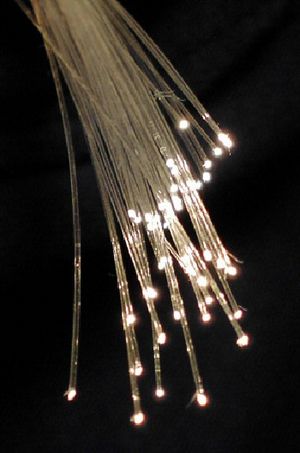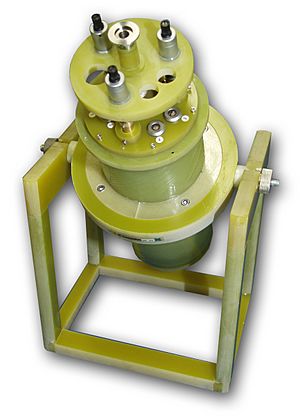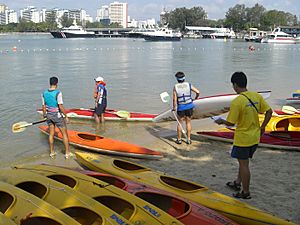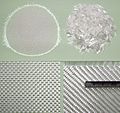Fiberglass facts for kids
Fiberglass (also called fibreglass or glass fibre) is a cool material made from super thin strands of glass. Imagine glass spun into tiny threads!
It's often used to make other products stronger, especially those made from polymers (which are like plastics). When fiberglass is mixed with a plastic, the new material is called a "composite material." You might hear it called "fiberglass," but its proper names are fiber-reinforced polymer (FRP) or glass-reinforced plastic (GRP).
People have played around with glass fibers for a long time. But it wasn't until machines became more advanced that we could make fiberglass in large amounts.
Contents
How Fiberglass is Made
Glass fiber is created by pushing thin strands of glass (usually made from silica) through tiny holes. This process is called extrusion. It makes many fibers with very small diameters, perfect for making textiles.
Glass is different from most plastics. Even as a fiber, it doesn't have a very organized crystal structure. It's more like an amorphous solid, which means its atoms are arranged randomly. The way glass acts when it's soft is very similar to how it acts when it's spun into a fiber.
What Fiberglass is Used For
Fiberglass is an amazing material because it's light, super strong, and can handle all kinds of weather. Plus, it can have different surface textures.
Scientists started looking into using fiber-reinforced plastic for everyday things in the 1930s. The aviation (airplane) industry was especially interested. In 1932, someone accidentally discovered a way to make lots of glass strands. A researcher at Owens-Illinois aimed a blast of air at melted glass and created fibers!
Later, in 1935, the Owens company joined with Corning to form Owens Corning. They improved this method to make their special "Fiberglas" (with one "s"). In 1936, another company, du Pont, created a good plastic resin to mix with "Fiberglas." By 1942, even better resins were developed.
During World War II, fiberglass became important. It was used to replace wood in airplane radomes (the nose cones that protect radar). Fiberglass is transparent to microwaves, which was perfect for radar.
After the war, fiberglass became popular for building boats and sports car bodies in the 1950s. Since then, its use has grown to include cars and sports equipment. For some products, like airplanes, carbon fiber is now used instead of fiberglass. Carbon fiber is even stronger for its weight and size.
New ways of making fiberglass, like pre-pregs and fiber rovings, have made it even stronger and useful for more things.
Fiberglass is also used in the telecommunications industry. It's great for covering antennas because radio signals can pass through it easily without losing strength. It can also hide other equipment like cabinets and steel supports. This is because it's easy to shape and paint to match existing buildings. You'll also find fiberglass in electrical insulators and parts for power-industry products.
Because fiberglass is light and tough, it's often used in protective gear like helmets. Many sports use fiberglass for masks and other safety equipment.
Storage Tanks
Big Storage tanks can be made from fiberglass. Some can hold up to 300 tonnes of material! Smaller tanks are sometimes made by casting chopped fiberglass over a plastic inner tank. Stronger tanks use woven fiberglass mats or wound fibers. These are often used for storing chemicals because the plastic lining (often polypropylene) can resist many harsh chemicals. Fiberglass is also used for septic tanks.
Building Houses
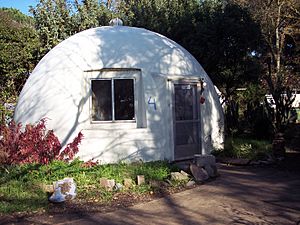
Glass-reinforced plastics are also used to make parts for houses. This includes roofing, door frames, window canopies, chimneys, and sills. Since fiberglass is lighter and easier to handle than wood or metal, it makes building faster. You can even find fiberglass panels that look like bricks. These can include insulation to help keep heat inside your home.
Pipes
GRP (glass-reinforced plastic) and GRE (glass-reinforced epoxy) pipes are used in many places, both above and below ground. They are used for:
- Making fresh water from salty water (desalination)
- Treating water
- Water pipes for homes and cities
- Chemical factories
- Firefighting water systems
- Hot and cold water
- Drinking water
- Wastewater and sewage
- Natural gas and LPG
Examples of Fiberglass Use
Here are some cool things made with fiberglass:
- Bows for archery
- Poles for pole vaulting
- Handles for tools like hammers and axes
- Traffic lights
- Boat hulls
- Rowing boats and oars
- Water pipes
- Helicopter rotor blades
- Surfboards and tent poles
- Gliders, kit cars, and car bodies (like the Chevrolet Corvette)
- Domes and other architectural parts that need to be light
- High-end bicycles
- Covers for antennas, like radomes
- Tanks and containers for chemicals
- Most commercial velomobiles (bicycle-like vehicles with a shell)
- Most printed circuit boards (the green boards inside electronics)
- Large blades for wind turbines
- Parts of MRI scanners
- Drum sets
- Covers for underwater installations
- Reinforcing asphalt pavement on roads
- Helmets and other protective gear in sports
- Orthopedic casts that are waterproof, so you can shower or swim with them
- Fiberglass grating for walkways on ships and in factories
- Columns that support buildings
- Water slides
Safety Tips
If you touch bare fiberglass without gloves, it can make your skin itchy or cause small cuts. Some people have worried that tiny fiberglass pieces could be breathed into the lungs. This could cause problems, similar to asbestos. Because of this, fiberglass has sometimes been called "man-made asbestos." Now, other materials like cellulose and aerogel are starting to be used for building insulation instead of fiberglass.
Related pages
Images for kids
-
This fiberglass statue is a copy of an old Roman bronze statue of winged Victory in the Santa Giulia museum in Brescia.
See also
 In Spanish: Plástico reforzado con vidrio para niños
In Spanish: Plástico reforzado con vidrio para niños


